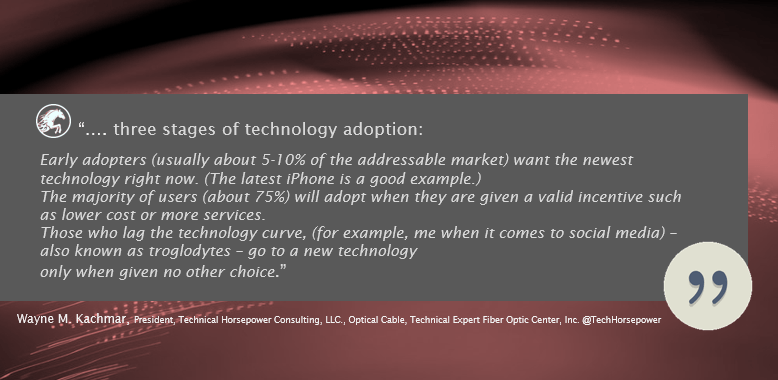What we do vs. what we wish to do‚ thoughts on the realistic integration of next-generation fiber optic technologies.
Today, fiber optic communications have been firmly established. We install networks both in the switched telephone and CATV networks with industry-standard methods, cables, and sometimes architecture. We have fiber to the home in large-scale implementations (FIOS, etc.). We regularly install fiber backbones in office buildings, in fact, sometimes even more than one provider’s network in a building. We extend our cellular network and back-haul almost exclusively on optical fiber.
If we are to believe the trade press, this is only the tip of the iceberg regarding what will happen. I do believe this. However, I question the pundits’ estimates regarding timing. I have watched as new technologies were declared “ready for primetime” and then did not live up to the hype. In many cases, the issues revolved around technological hurdles as well as financial ones. When the technologies finally did make economic sense, the large-scale installs occurred.

Many times in my career I have seen a market development specialist describe the three stages of technology adoption:
- Early adopters (usually about 5-10% of the addressable market) want the newest technology right now. (The latest iPhone is a good example.)
- The majority of users (about 75%) will adopt when they are given a valid incentive such as lower cost or more services.
- Those who lag the technology curve, (for example, me when it comes to social media) – also known as troglodytes – go to a new technology only when given no other choice.
Based on the above breakdown, many of the newest technologies will only see limited success in the short term. However, those steeped in the frontend learning curve will be best positioned to meet the demands of the largest bulk of users who must be given an incentive to install and use the new technology.
As I look today at the utilization of passive optical networks (PONs) fiber to the premises and optical drop cables to extend the cellular network, I see that the incentives are mostly cost and convenience. Communities want good broadband access to attract residents and businesses, so they will suffer the time and discomfort to install a new network. In most cases, the reason the network is wanted – and valued – is that the client users of the medium (e.g., social media) have made use of higher bandwidth. So the actual incentive is not always for the end-user (you and me), but rather to the merchants and municipalities that want us to spend our money in their locations.
Looking at the above assumptions, I would postulate that many of the next-generation technologies will be less likely to invade our lives before we have truly enjoyed the benefits of the present upgrades, which may take advantage of one or two previous generations of optical fiber, cable, and system design. In that vein, I do not see the short-term benefits of some of the newest technologies considering some of the obstacles yet to be overcome: these are both in technology and cost.
Some moving-forward technologies include:
- Ultra-dense wave division multiplexing
- Multi-core optical fibers (and their connection issues)
- No truck roll PON provisioning
- Ultra-high bandwidth fibers
That said, I do see many technologies that are well on their way to rapid inclusion in standard systems. This includes technologies such as:
- Blowing and jetting cable installation
- Remote line testing
- Virtual patch panel maintenance systems
- Pushable cables
As you can see from my comments above, I am not picking winners and losers in technology but rather identifying when these various technologies will integrate into our systems. Plus, I’m providing my view on what forces will push that integration.



